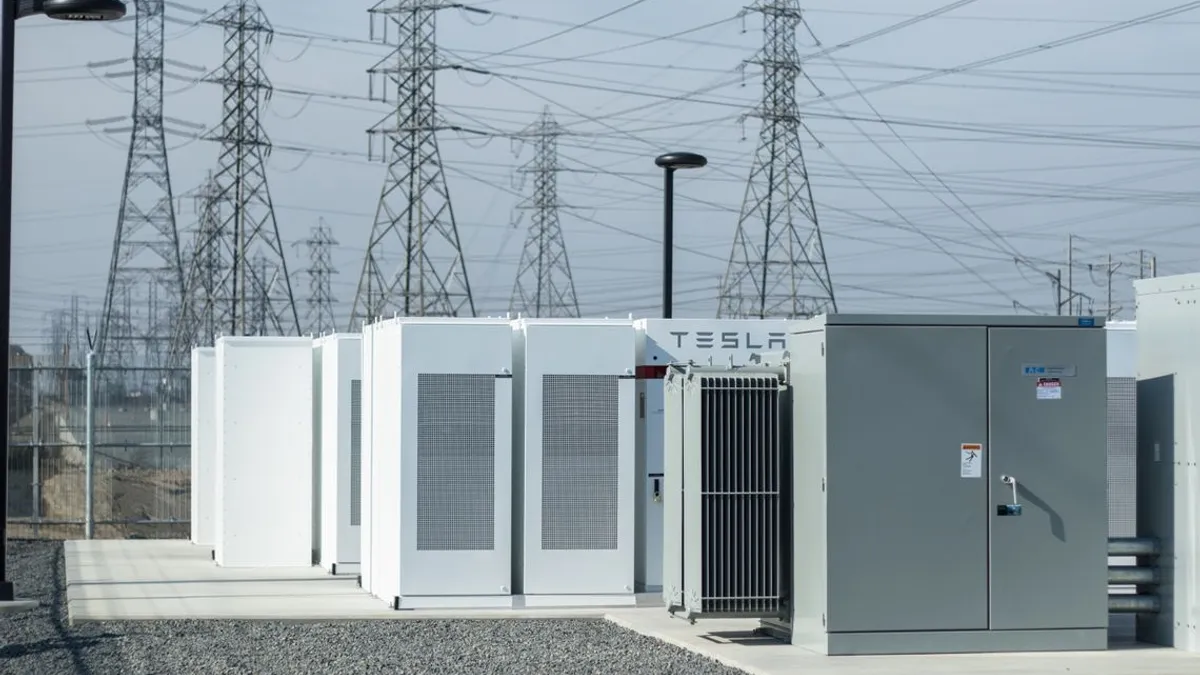Dive Brief:
- Southern California Edison (SCE) is procuring a 770 MW/3,080 MWh package of battery resources to bolster grid reliability, the utility announced May 1, in what would be one of the largest storage procurements made in the United States to date.
- The battery projects will "enhance electric grid reliability and help address potential energy shortfalls identified in California," SCE said in a press release, adding that they would also help California’s broader clean energy transition as multiple coastal once-through-cooling (OTC) plants approach retirement dates in the next three years.
- The scale of the projects is "hard to describe," Daniel Finn-Foley, head of energy storage at Wood Mackenzie Power and Renewables, told Utility Dive, since this single procurement is more than the entire energy storage market in the U.S. for all of 2019. "The word hockey stick gets thrown around a lot, but that is some real exponential growth in the storage market," he added.
Dive Insight:
California presents the "perfect storm" for energy storage growth, Finn-Foley said: a first-in-the-nation mandate, a forward-looking, single-state independent system operator, aggressive clean energy targets and a resource planning system that’s entering its new cycle right as energy storage with solar is emerging as one of the key solutions for the future.
SCE’s proposed projects would partially address concerns raised by the California Public Utilities Commission (CPUC) last year, in a decision seeking extensions for 4.8 GW of gas generation units: reliability issues stemming from retiring OTC resources, shifting peak periods and the increasing levels of renewables on the grid.
"These new emissions-free projects will help us ensure the reliability of the grid for our customers and integrate an ever-increasing amount of clean renewable energy over the next decade," William Walsh, SCE vice president of energy procurement and management, said in a statement.
The utility has entered into contracts with seven battery projects developers, ranging from 50 MW to 230 MW with 10 to 20-year contract terms, all of which are slated to come online in August 2021. Most of the projects are co-located with adjacent solar power plants, at the same point of interconnection — "the first of their kind on California’s grid," SCE said.
The utility plans to approach the CPUC to approve the contracts later this month.
The largest of the projects is a 230 MW facility by NextEra Energy in California’s Riverside county. The company recently announced on its Q1 earnings call that it expects to invest more than $1 billion in battery storage in 2021. "Now we know a little bit about where that NextEra $1 billion is going to in 2021," Finn-Foley said.
California’s energy regulators also think battery storage will play a critical role in the state’s broader effort to supply all electricity from zero-carbon resources by 2045. The CPUC recently adopted an optimal resource portfolio to get the state to its goals, which requires 1 GW of long-duration storage by 2026 and tripling battery storage capacity.
"The main theme of what’s going on here… is that the California grid is actively evolving away from the old fleet and into the new fleet," Alex Morris, executive director of the California Energy Storage Alliance (CESA), told Utility Dive. "It makes sense that Edison is taking a leadership role here, as they have been on the frontlines of prudent transitions for the electric system for some time."
However, this announcement is "just another step" in a larger transition towards storage procurement, he said.
The utility is facing a tight timeline to get the projects up and running, but "one of the main lessons from California over the last five years is energy storage solutions can be built pretty aggressively, way faster than historical projects were built," Morris said.
"The idea of deploying 770 MW of energy storage at this scale has never been tried in the U.S. before," Finn-Foley concurred, adding, "That means these companies that they have contracted with are going to have to really pull out all the stops."
However, he noted that SCE’s proposal has a lot going for it — many of the storage systems will be attached to existing solar facilities, and a lot of the infrastructure they’d need will already be on-site.
The projects co-located with solar facilities are noteworthy, "because we see an increasing capability in California for developing these hybrid projects. Partly, it saves California money by taking advantage of federal tax rules, and then it also can just be prudent in some instances," Morris said, adding that CESA has been working for many years to develop proper capacity counting rules and market participation paths for these resources.
SCE isn’t the only California utility looking to battery storage to smooth over reliability issues — in 2018, Pacific Gas & Electric (PG&E) announced contracts with four battery projects totaling 567 MW/2,270 MWh for reliability purposes, including the 182.5 MW Tesla battery project at its Moss Landing substation, which is expected to come online in 2021.
The CPUC has identified a need for both short and long-duration energy storage to meet climate goals, but "there remain barriers to developing long duration energy storage on the timeline needed to achieve the state’s climate goals. We need resolution and forward planning from state policymakers to advance a diverse and cost-effective mix of storage solutions," Julia Prochnik, executive director of the Long Duration Energy Storage Association of California, said in an emailed statement.















